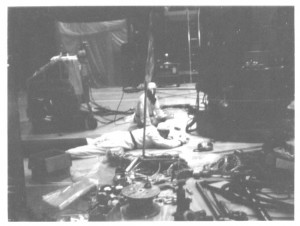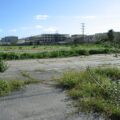 50 Years After a Santa Susana Nuclear Accident Holds Up Land Development
50 Years After a Santa Susana Nuclear Accident Holds Up Land Development
By Michael Collins
All hell was about to break loose at the Sodium Reactor Experiment on July 23, 1959. The reactor, tucked into a corner of the Santa Susana Field Laboratory in the Simi Hills 30 miles northwest of downtown Los Angeles, was constructed without a radiation-containment dome and was in the 10th day of partial meltdown.
On top of the reactor core, a worker operating a 30-foot-high, lead-lined “coffin,” used to extract uranium fuel rods, came across a fuel rod that wouldn’t budge. He started rocking the coffin back and forth, when something went terribly wrong.
“The guy was pulling on the thing real hard, and it was stuck in the reactor,” says John Pace, 70, the last known surviving lab worker present during the meltdown. A chemical known as Tetralin “made a bunch of goo in the bottom of a pool and the rods were damaged. Then the goo freed up and they went, ‘What the hell happened there?’”
Looking into the coffin’s “window,” the Atomics International mechanic realized that the fuel rod had broken off and now was exposing the whole building to severe radiation. That radiation threatened to contaminate the 2,850-acre field lab. The reactor stood on the federal Department of Energy’s 90-acre portion of the property.
“All he could think to do is run and, and as he was running, he was pulling alarms,” Pace today tells L.A. Weekly. “They were realizing radiation was leaking out in the atmosphere. Somebody volunteered to go back in and put the fuel rod back down in the reactor.”
Radiation flooded the building and contaminated everything in it. Pace helped seal off the control room with tape and ended up cleaning the floors and walls with sponges and mops until he realized that the best way to clean up the contaminated reactor was with Kotex pads. Pace sneaked in his Polaroid camera and took photos of frantic attempts to bring the reactor under control.
The Sodium Reactor Experiment meltdown damaged 13 of the reactor’s 49 fuel rods. Although the exact amount of radiation released is not known, by some estimates, it amounted to 260 to 459 times more radiation than the famous meltdown at Three Mile Island in Pennsylvania 20 years later in 1979.
Where the nuclear fallout blew is under dispute, and is fueling a controversy today over whether KB Home should proceed with a plan to develop the adjacent lands known as Runkle Canyon.
In later years, the subsequent owners of the Santa Susana lab, Boeing Co., said it didn’t have the wind data from that day 50 years ago — and even if the company did, they considered it proprietary information and wouldn’t part with it.
But Pace says he knew which way the wind was blowing during the meltdown because he was the designated weatherman. During that period, he says, the prevailing wind was traveling from the Simi Hills directly toward the highly populated San Fernando Valley.
Pace says, “At the time of the meltdown, it went … toward Los Angeles and the Valley. I know it went exactly over L.A. It was just a normal westerly wind blowing over the San Fernando Valley and beyond.”
A California state study in 2006 estimated that hundreds of people in a 62-mile radius around the lab contracted cancer from the meltdown, but researchers were hampered by Boeing’s refusal to hand over the data on wind direction. Local outrage led Boeing to finally release the information, confirming Pace’s account that it was moving toward the Valley.
It was 1959, and coverup of the meltdown had begun almost immediately. Three weeks after the reactor was finally shut down July 26 of 1959, the Valley Green Sheet, forerunner to the Los Angeles Daily News, ran an article saying that “a parted fuel element” was observed and that “no release of radioactive materials to the plant or its environs occurred, and operating personnel were not exposed to harmful conditions.”
But Pace alleges that radiation readings were so high, workers’ radiation-exposure badges were confiscated and stored in a safe. Pace blames the radiation for a diagnosis of temporary sterility in 1966 after failing to conceive children with his wife Geneva, who subsequently had five miscarriages before giving birth to their three children.
In 1998, L.A. Weekly began its coverage of contamination coming from the huge field-lab facility. In that coverage, former employee Dan Parks revealed that reactor core gases were vented — or allowed to escape into the atmosphere — all the time, before and after the meltdown (see “Total Recall,” Dec. 17, 1998.) At the time, Parks said that all 10 of the nuclear reactors followed that practice.
Earlier in 1998, Boeing’s public-relations flack Dan Beck slid a copy of the 1959 Valley Green Sheet article across a table to this reporter in a meeting in Canoga Park as proof that the meltdown incident was not covered up.
Today, a cleanup effort arising from Gov. Arnold Schwarzenegger’s signing of Senate Bill 990 in late 2007 is under way. The cleanup is intended to ensure that the entire acreage is returned to the highest environmental standards possible and that parkland is created.
One of the biggest concerns that remains is whether chemical or radiological contamination has drifted off-site over time.
In late 2007, Boeing supplied the state regulators in charge of the cleanup, known as the Department of Toxic Substances Control, with a 199-page Offsite Data Evaluation Report, which explained the results of 60 years of “off-site media sampling and testing data for chemical and radiological contamination” that had been collected by Boeing, NASA and the Department of Energy within a 15-mile radius around the Santa Susana Field Laboratory.
Bizarrely, the report claims that during those 60 years, Runkle Canyon’s ground water and soil were never tested. But, in fact, at least one test was conducted, according to a 2007 report prepared for Boeing and obtained by the Weekly.
Signed under penalty of perjury by Thomas D. Gallacher, Boeing’s director of Environment, Health and Safety at the laboratory, the report also says that the area where most of the nuclear work was done — Area IV — does not border the adjacent Runkle Canyon. Yet the report has maps illustrating that picturesque Runkle Canyon does indeed border Area IV. One map also shows evidence of toxic trichloroethylene in the Runkle Canyon ground water.
Boeing, which bought the huge laboratory acreage in 1996, has not yet responded to L.A. Weekly‘s questions about these issues.
The apparent discrepancies in the 2007 report trouble “Toxic Terry” Matheney, an aerospace worker who is a member of a Simi Valley activist group called the “Radiation Rangers,” which has fought the plans of Westwood-based developer KB Homes to build 465 homes in Runkle Canyon. The Rangers have successfully delayed development of the site since 2006.
In echoes of the controversy over Ahmanson Ranch, a now-abandoned plan to build 3,050 homes on open hills tucked between the western San Fernando Valley and the Simi Hills, critics say that Runkle Canyon is polluted with strontium-90, cesium-137, arsenic, chromium and the rocket fuel oxidizer perchlorate (see “Earthly Secrets,” June 12, 2002).
“Runkle Canyon is even more polluted than Ahmanson Ranch,” Matheney insists. He believes constructing a residential development in Runkle Canyon “will send up a radioactive dust cloud weighing more than 112 tons, which will blow over and fall out on the Simi and San Fernando valleys. This isn’t 1959, a time when the company and government could lie their way out of environmental crimes perpetrated against its workers and neighbors, not on our watch.”
27 Years of Award-Winning SSFL/Rocketdyne Reporting
1998 – 2025












Recent Comments